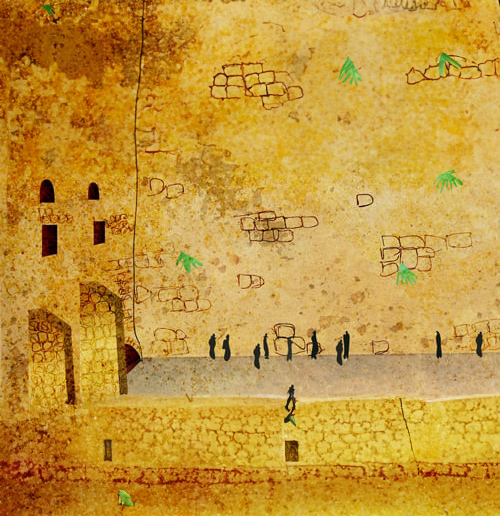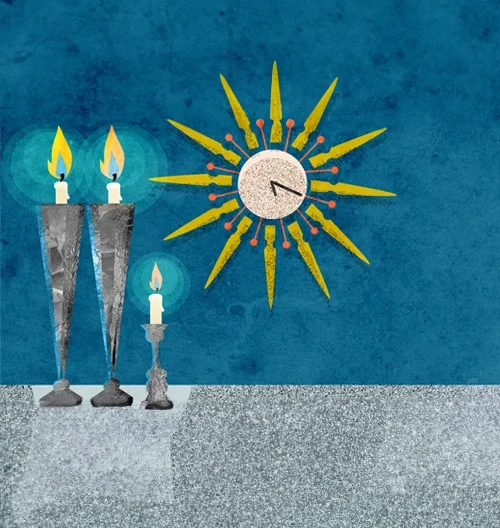|
Getting your Trinity Audio player ready...
|
By: Chabad.org
The Three Weeks: What and Why
For eight hundred and thirty years there stood an edifice upon a Jerusalem hilltop which served as the point of contact between heaven and earth. So central was this edifice to the relationship between man and G‑d that nearly two-thirds of the mitzvot are contingent upon its existence. Its destruction is regarded as the greatest tragedy of our history, and its rebuilding will mark the ultimate redemption-the restoration of harmony within G‑d’s creation and between G‑d and His creation.
A full three weeks of our year—the three weeks “between the strictures”1 of Tammuz 17 and Av 9—are designated as a time of mourning over the destruction of the Holy Temple and the resultant galut—physical exile and spiritual displacement—in which we still find ourselves.
In this period, many calamities befell the Jewish people throughout the generations. It was during this period of between the straits that both the first and second Temples were destroyed.

Conduct During the 3 Weeks
During this period, we lessen the extent of our rejoicing. We don’t:
Conduct weddings. (Engagement parties – without music – are allowed until Rosh Chodesh Av.)
Play musical instruments or listen to music.
Recite the Shehecheyanu blessing. Thus, we do not wear new clothing or eat fruit which we have not yet eaten this season so that we will not be required to recite Shehecheyanu.
Take a haircut or shave. Many Sephardic communities permit haircuts and shaving until the week of Tisha b’Av.
(Speak to your rabbi if there are extenuating circumstances that prevent you from observing any of the above customs.)
Shabbat
All the laws of mourning are suspended on Shabbat.2 This includes the 17th of Tammuz and the 9th of Av3 themselves—when they fall on Shabbat, the fast days are postponed until Sunday, and the Shabbat is joyously celebrated. The Rebbe stated on numerous occasions that on these Shabbats we must increase our joy, and add an extra tasty dish to our meals, to emphasize that we are not in a state of mourning.
On the first Shabbat of the Three Weeks (or on the 17th of Tammuz itself, if it falls on Shabbat) we almost always read the Torah portion of Pinchas. The end of the reading discusses the three Jewish festivals. It has been said amongst chassidim that this alludes to the idea that the three Shabbats of the Three Weeks are to be celebrated on par with the three festivals…
Why is all mourning suspended on Shabbat?
Though these days and weeks heralded an exile rife with persecution and spiritual estrangement, it is our belief that ultimately this is for the good. Very soon, with the coming of Moshiach, we will understand that all the suffering was necessary in order to reach the ultimate good. At that time, the prophets foretell, these sorrowful days will be transformed into days of joy (see Breaking Walls for more on this topic).
Every Shabbat constitutes a foretaste of the Messianic Era. As such, on Shabbat we only focus on the positive element of this period.
Determination to Rebuild
Aside from the aforementioned “technical” rules and restrictions, during this period we spend extra time contemplating the less-than-perfect state the world is in now and what we can do to improve it by increasing in deeds of goodness and kindness.
The Rebbe urged that the Three Weeks should be a time of increased Torah study and giving of charity– in keeping with the verse,4 “Zion shall be redeemed by law, and her returnees by charity.” Particularly, the Rebbe requested time and again the study of those portions of Torah that deal with the building of the Holy Temple.
Why these laws? The Rebbe based his request on a dialogue, cited in the Midrash,5 that transpired after G‑d told the Prophet Ezekiel to instruct the then exiled Jewish People about the measurements and design of the third Holy Temple:
“Master of the world,” Ezekiel replied, “why are You telling me to go and tell Israel the form of the House; they are now in exile in the land of our enemies—is there anything they can do about it? Let them be until they return from the exile. Then, I will go and inform them.”
G‑d answered: “Should the construction of My House be ignored because My children are in exile? The study of the design of the Holy Temple as detailed in the Torah can be equated to its actual construction. Go tell them to study the form of the Holy Temple. As a reward for their study and their occupation with it, I will consider it as if they actually built the Holy Temple.”
It is our generation in particular, that stands on the threshold of Redemption, that must study these laws with the awareness that these laws will be quite practical in the imminent future!

From Destruction to Renewal
But there is more to the Three Weeks than fasting and lamentation. The prophet describes the fasts as “days of goodwill before G‑d”-days of opportunity to exploit the failings of the past as the impetus for a renewed and even deeper bond with G‑d. A sense of purification accompanies the fasting, a promise of redemption pervades the mourning, and a current of joy underlies the sadness. The Ninth of Av, say our sages, is not only the day of the Temple’s destruction—it is also the birthday of Moshiach.
May we soon merit the fulfillment of the prophecy: “I will turn their mourning into joy and will comfort them and make them rejoice from their sorrow” (Jeremiah 31:12).
FOOTNOTES
- This is based on the verse (Lamentations 1:3) which states: “All of [Israel’s] pursuers overtook her between the straits.” The Sages (Eichah Rabbah 1) explained that “between the straits” refers to the days of affliction between the seventeenth of Tammuz and the ninth of Av.
- An exception is that in many communities – including Chabad – we don’t recite the Shehecheyanu even on Shabbat. During the 9 Days (Shabbat Chazon), in some communities, certain elements of sadness are preserved even on Shabbat, and people do not dress up as usual and the prayers are sung to sad tunes. The Chassidic custom, however, is to desist from all public displays of mourning.
3 If the 9th of Av falls on Shabbat (or if Shabbat is on the eve of the 9th of Av) there are certain mourning observances practiced in private—though this doesn’t interfere with the public festive atmosphere. .
- Isaiah 1:27.
- Tanchuma, Leviticus 14.





